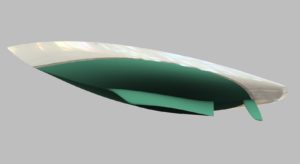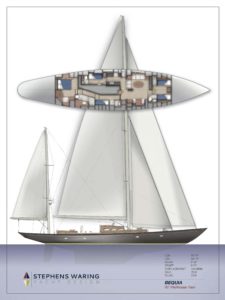Talking about racing sailboats starts a competitive debate around here. On one hand, we’re still the boat-nerds dreaming of deconstructing a Vendee Globe or America’s Cup racing rule to unlock the hidden speed secrets that take the silver home. All designers dream of sailing glory. But on the other, experience has taught us that real raceboats are a bummer. The dumb things go out of date before they’re even built. And the boat you wind up having to sail is a beast: Rough. Wet. Dangerous. And that’s assuming you know how to sail fast. Most of us live through the nautical murder of slowly slogging along, crawling along in a boat meant to go fast. It’s a killer.
Instead, time has taught us to stick to our wholesome Spirit-of-Tradition naval knitting. We seek to design boats that are comfortable, look fabulous, yet still flash plenty of speed for fun and safety. And if you win your Wednesday night ‘round-the-can races with your buddies, all the better. That’s racing Stephens-Waring style.
Thing is, in our world sometimes this sort of racing among friends turns into serious competition among seriously competitive sailors. And earlier this summer, one of our favorite 90-foot yawls, Bequia, shaped up for the America’s Cup Superyacht Regatta 2017 in Bermuda, skippered by no less than Tom Whidden, president and CEO of North Technology Group, in Milford CT; where he manages the core North Sails brand, as well as companies like Southern Spars, North Apparel and EdgeWater Boats. Tom gets going fast in sailboats. He’s actually won a real America’s Cup, back in the day. And he’s one of the few sailors that legends like Dennis Connor actually listen to out on the race course. Whidden helmed Bequia to a win in her class, and within just a point or two of taking the honors for the entire regatta.
To be honest, we never expected results like this: Bequia is no slouch speed wise, but she is a 135,000 pound, 3-bathroom, 9-bed luxury yawl. So we immediately got on the phone with Whidden to find out where the performance came from. And in the process, we learned a big lesson about winning races. In most cases, speed on the race course has little to do with the highest tech. What matters, says Whidden, is choosing not to invent reasons to lose.
Here’s our chat, edited for length and layout, with some relevant design drawings to show the true boat-nerdery involved.
First off, what’s your relationship to Bequia?
TW: I have been sailing with her owner for years. And I was invited to give my thoughts on her original design. I always considered this boat a floating work of art. All I did was look at the sailplan and wonder if she would go a bit a better with a fractional rig. I had one drawn up. I spoke with Bob Stephens about it. He liked what he saw. And that’s what she carries now: Small mizzen and large fully-battened fractional main. That was my two-cents design wise.
It seemed that you had plenty of speed in Bermuda. Why?
TW: Well, Bequia is a slippery hull that moves easily through the water. It was not hard to get her moving, despite her 136,000 pound displacement. For her handicap, she goes well to windward and surprisingly well downwind. She goes well with a relatively small Genoa and a beautiful and large asymmetrical spinnaker. It turned out reaching was the hardest part for her to perform well, against the fleet, given her handicap.
There is no magic, then, in the design that made Bequia fast?
TW: Bob Stephens did a wonderful job with Bequia. But what made her more competitive, are many of the basics any boat can have: Carbon spars and rigging, none of which are particularly high-tech in this day and age; sensible 3D laminated sails. You don’t even need to buy one of ours from North Sails. Any good well-shaped sail is all you need. These are surprisingly rare, even at the superyacht level.

A slick, 3D peek at Bequia’s slippery hull, shallow cruising draft and powerful foils for lift to windward.
Hold on. Superyachts scrimp on performance features?
TW: Absolutely. Things like carbon, non-rod rigging are becoming more prevalent in otherwise luxurious boats, But many still have old style, very slow rigs. It seems like superyacht owners shy away from racing. Yet, they’re otherwise very successful in life. So they tend to avoid features that sound high-tech and racy: ‘We don’t bother with a carbon spar, because we don’t race,’ is what you hear.
It feels too race-oriented for them. So they don’t have them. Once they get out and race, they wish they did.
Let me get this straight, even though budget is not an issue, some boats actively avoid the tools they could use to go fast?
TW: You never want to come out and say this directly to an owner, but it often feels like they’re finding excuses to lose. That way they are not responsible for the result. You would be surprised how few boats at the mega yacht regattas even bother to clean, much less fair, their bottoms. It keeps them from looking too competitive to their peers.
All the stuff you would do for your basic Laser frostbiting fleet just doesn’t happen at this level. It’s sort of amazing.
We’re not even talking about crew and tactics or what makes the boat go fast? It’s simple design features that we all know.
TW: Correct. Certainly, you want a crew that enjoys sailing in good style. And they should have the team aspect of it all. I’m fortunate that I have had some good luck on the race course. But at the end of the day, the path to true performance and winning is not only paved with money. Once you have a reasonable boat, it’s about the basics of a fair, clean hull, sensible sail plain, carbon spars, 3D sails, and a crew who cares and gets organized about stuff like the weather and tactics. I took home a victory in a regatta recently and we had 7-year old sails. It’s really not only an arms race.
We are at the point where there is so much un-tapped potential out there, that if you just made an ordered attempt to make your boat faster and safer, you have a good chance winning.
Speed is not rocket science anymore. You can quote me on that.


